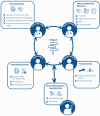Multidisciplinary strategies to treat painful mononeuropathies in the upper extremity: from lab to bedside
- PMID: 38749904
- PMCID: PMC11143763
- DOI: 10.1177/17531934241240389
Multidisciplinary strategies to treat painful mononeuropathies in the upper extremity: from lab to bedside
Erratum in
-
Corrigendum to 'Multidisciplinary strategies to treat painful mononeuropathies in the upper extremity: from lab to bedside'.J Hand Surg Eur Vol. 2024 Oct;49(9):1180. doi: 10.1177/17531934241263253. Epub 2024 Aug 19. J Hand Surg Eur Vol. 2024. PMID: 39157980 Free PMC article. No abstract available.
Abstract
Neuropathic pain in the upper extremity is a serious problem, commonly involving relatively young patients. The pain causes loss of function and productivity, changes a patient's lifestyle and can progress into a chronic pain syndrome with secondary psychosocial co-morbidities. Treating patients with a painful mononeuropathy remains challenging, with a monodisciplinary approach often having limited treatment efficacy. This narrative review discusses how to deal with this challenge in the treatment of patients with peripheral nerve injury pain, addressing the four important pillars: (1) diagnosing a painful mononeuropathy; (2) clinical pain phenotyping; (3) personalized pain treatment; and (4) using a multidisciplinary team approach.
Keywords: Multidisciplinary; mononeuropathy; pain; phenotyping.
Conflict of interest statement
Declaration of conflicting interestsThe authors declared the following potential conflicts of interest with respect to the research, authorship, and/or publication of this article: MR performs consultancy work for Synerkine Pharma, which is not related to the present manuscript.
Figures



Similar articles
-
Peripheral Nerve Stimulation for Painful Mononeuropathy Secondary to Leprosy: A 12-Month Follow-Up Study.Neuromodulation. 2018 Apr;21(3):310-316. doi: 10.1111/ner.12714. Epub 2017 Oct 29. Neuromodulation. 2018. PMID: 29082637 Clinical Trial.
-
Ultrasound-controlled cryoneurolysis for peripheral mononeuropathies: a retrospective cohort study.Pain Manag. 2023 Jun;13(6):363-372. doi: 10.2217/pmt-2023-0053. Epub 2023 Jul 9. Pain Manag. 2023. PMID: 37424263
-
Less common upper limb mononeuropathies.PM R. 2013 May;5(5 Suppl):S22-30. doi: 10.1016/j.pmrj.2013.03.021. Epub 2013 Mar 21. PM R. 2013. PMID: 23523706 Review.
-
Surgical Treatment of Upper Extremity Pain.Hand Clin. 2016 Feb;32(1):71-80. doi: 10.1016/j.hcl.2015.08.008. Hand Clin. 2016. PMID: 26611391 Review.
-
Painful diabetic neuropathy: clinical aspects.Handb Clin Neurol. 2014;126:53-61. doi: 10.1016/B978-0-444-53480-4.00005-9. Handb Clin Neurol. 2014. PMID: 25410214 Review.
References
-
- Adidharma W, Khouri AN, Lee JC, et al.. Sensory nerve regeneration and reinnervation in muscle following peripheral nerve injury. Muscle Nerve. 2022, 66: 384–96. - PubMed
-
- Arnold DMJ, Wilkens SC, Coert JH, Chen NC, Ducic I, Eberlin KR. Diagnostic criteria for symptomatic neuroma. Ann Plast Surg. 2019, 82: 420–7. - PubMed
Publication types
MeSH terms
LinkOut - more resources
Full Text Sources
Miscellaneous

